Stories
Brigid Brock
1970-1992 (label)
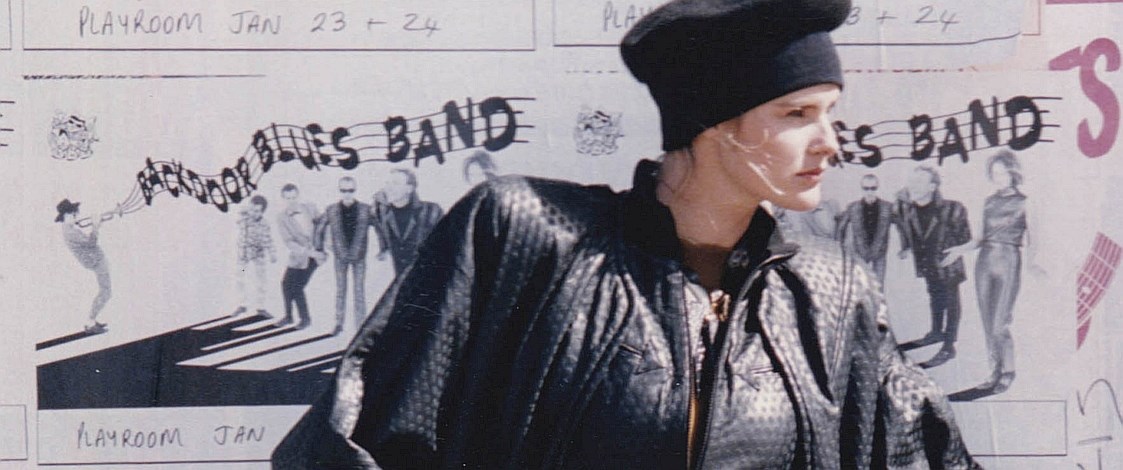
Renowned for her rapport with leather, Brigid Brock’s name is synonymous with 1980s’ high fashion. Her highly individualised pieces sometimes come up for sale, but not often. They were so beautifully crafted and so representative of the era, their owners usually opt to keep them.
Says Stephanie Tattersfield, formerly sales director of Saks (Auckland) which, along with Plume (Dunedin), Panache (Christchurch) and Memsahib and Zambesi (Auckland), was one of the prestigious stores to stock the Brigid Brock label: "The jacket I have of hers is an over-sized blouson in black suede imprinted with a design similar to a fleur-de-lis. It’s heavily padded and very warm and I wore it for several years on winter buying trips for Saks to Europe. I’d still be wearing it today if the style hadn’t gone out of fashion."

Full-length coat in cobalt blue New Zealand lambskin screen-printed with fine yellow dots. Winter 1986.
Although Brigid constantly refined her design concept, her natural inclination was toward the European aesthetic, which favoured an almost throwaway approach to luxury leather. Her designs were distinguished by variations in shape and proportion. Being the 1980s, big shoulders were a given. While some jackets were tight, taut and tapered in at the waist, others were designed as roomier blousons, boleros and enveloping 3/4 length coats. Most came with succinctly shaped matching skirts or trousers. Cleverly contrived vests and shirts created further wardrobe options.
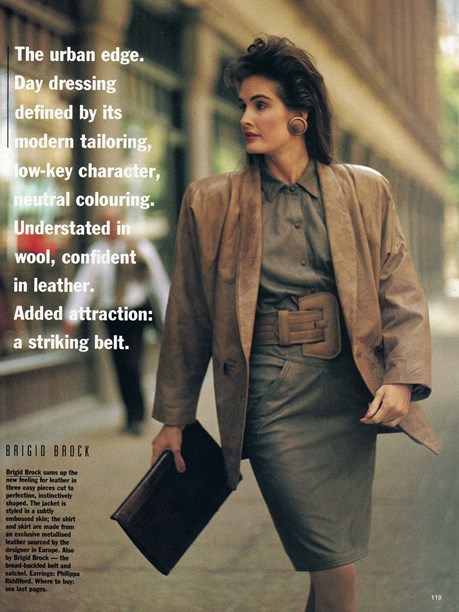
Embossed leather jacket and matching big-buckle belt teamed with a pencil skirt and shirt in fine metallic embossed suede. City dressing photo shoot, Fashion Quarterly, Winter 1988. Photo by Ken Middleton.
Many of the pieces were in black or darker shades, sometimes a combination of two colours, black and charcoal grey for example, in the one garment. The darker colours were mainly confined to winter, using screen-prints on New Zealand lambskin, and French and Japanese embossed leathers.

Grey and black jacket, vest, pencil skirt and matching clutch made from Japanese cowhide treated to create the softness of lambskin. Fashion Quarterly, Autumn 1987. Photo by David Robin.
For her summer collections, Brigid worked with lightweight split skins in bright colours, some of which, such as a sharp tangy lemon caught in mid-fizz with a squeeze of lime, were of her own invention. These exclusive colours were dyed-to-order for her each season by Timaru tannery NZ Light Leathers. The garments were sampled using co-ordinating screened and printed plain leather that could be mixed and matched, enabling stores (and clients) to create their own exclusive combinations.
A burst of colour. Screen-printed New Zealand lambskin collection, Spring/Summer 1987/88.
Brigid didn’t confine herself to using local leather. Skins imported from tanneries in Spain, France, England and Japan, which drew on generations of specialisation, added to the label’s exclusivity.
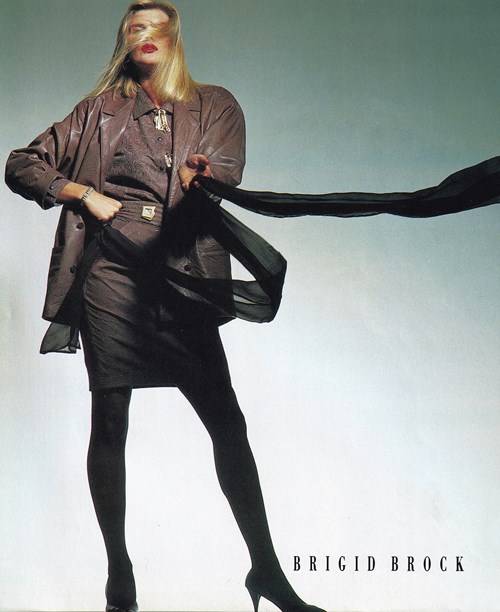
Advertisement for embossed suede pencil skirt and shirt with co-ordinating embossed leather jacket in a different pattern. All skins imported from France. Winter 1989.
The cost of skins never inhibited Brigid’s thinking. The design always took priority over the skin size. She says the line of the garment was more important than wastage in an irregular shaped skin and that she fought to avoid seams she didn’t want, even if cutting the leather would make a garment more economical to produce. Later, she designed small accessories such as sunglasses cases and coin purses to use up some of the wastage.

These meticulously cut pieces in English leather and finely embossed suede were available in seven co-ordinating shades. Spring/Summer 1988/89.
Taught to sew by her art teacher mother, Dunedin-born Brigid was making her own clothes when she was 10. She made a complete wedding trousseau, including a suit, for a friend’s older sister when she was 18 and opened her first clothing shop in Dunedin, selling her own designs, when she was 20.
Married at 21, Brigid moved to Auckland and became a cutter for the clothing label Paraphernalia. After a stint in production design in a Sydney knitwear factory, she returned to Paraphernalia as designer. Her next job was designing for the young fun fashion label Fotheringay, where she worked alongside future Vamp founder Walter Hart. In 1973, she "reluctantly" left Auckland for Christchurch, in order to further her husband’s career. She was succeeded at Fotheringay by Elisabeth Findlay, later of Zambesi.
Brigid Brock photographed in the late 1980s.
In Christchurch, Brigid worked from home, making one-off designs which she sold, along with items of vintage clothing, at Mollet Street Market. In 1977, as a step-up from a market situation, and to create a more interesting setting for her clothes, she opened a vintage fashion boutique in Christchurch’s oldest commercial wooden building, a city landmark that she renovated and named Shand’s Emporium after the original land-owner. One of the tenants of the rooms she sub-let as small shops was Dollie Vardin milliner Ailie Miller. Damaged in the 2010/2011 earthquakes, the building has since been moved to a new locale where it is being restored, complete with Brigid’s original gold signage.

‘Brigid Brock of Shand’s Emporium.’ Christchurch Antique Dealers Calendar 1978.
After opening a second vintage boutique, in New Regent Street, Brigid then moved to a retail space in the newly opened Shades Shopping Precinct and began making her own designs again.
There were very few hosiery choices in the 1970s – most women wore skin-toned pantyhose - so when her sister returned from London with colourful footless tights, Brigid was quick to spot an opening in the market. Brox Sox, her range of decorative tights, was manufactured by Lane Walker Rudkin and dyed at home by Brigid, initially in a pot on the stove and later in the washing machine. As demand grew, the tights were professionally dyed and the collection expanded to include patterned socks and screen-printed pantyhose. The business moved from a home-based operation to city premises, with 13 staff and 400 stockists in New Zealand and Australia. Brigid sold Brox Sox in 1988.
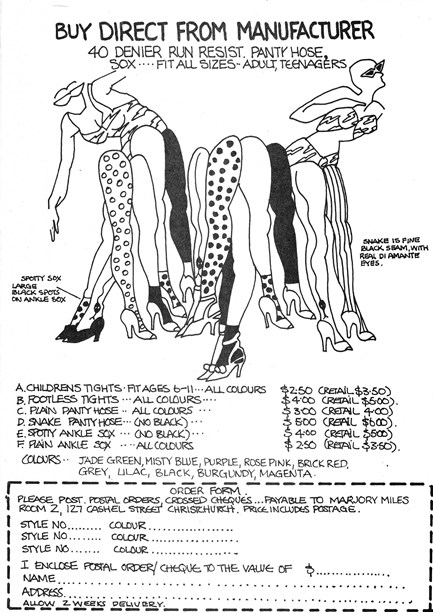
Mail-order catalogue for Brox Sox prior to the brand commencing wholesaling.
The opportunity to design leatherwear for Marguerite Leather came about through a chance conversation at a Christchurch dinner-party in 1983. Brigid did several collections for the firm until the head-company replaced the managing director unexpectedly and Brigid chose not to continue the association.
In 1985, the Melbourne leatherware company Bisonte began manufacturing her designs. As she describes it, it was a dream relationship without any restrictions. The skills of a Polish sample machinist and a London-trained pattern-maker were placed at her disposal, and there were no quibbles about her insistence on having the best buttons, zips, linings and shoulder pads.
That same year, the Christchurch leatherwear manufacturer, Marcol Manufacturing, approached Brigid to create collections for the New Zealand market. With initial reservations about the standard of the factory’s work, she agreed, with the proviso that she could retrain the machinists and staff to produce the high quality garments that defined her brand. Her "brilliant Melbourne pattern-maker" continued to make her patterns. Brigid did her own garment sketches, working drawings from which the patterns were made. It was during this time that she developed the distinctive screen-prints that became her signature.
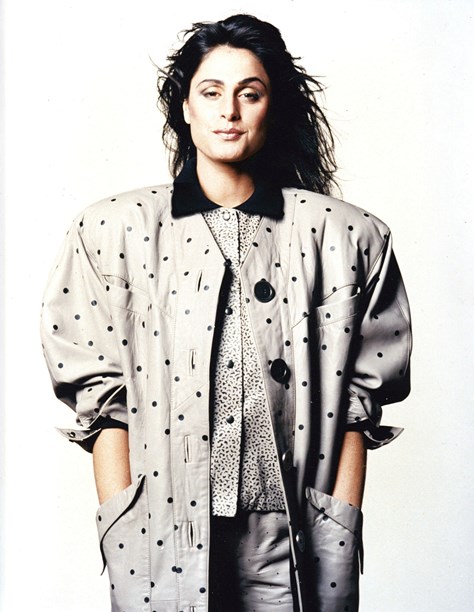
Mix and match screen-printed New Zealand lambskin jacket, shirt and pants. Spring/Summer 1987/88.
With a view to providing the women who bought her clothes with co-ordinated accessories, she often used the same screen-printed leathers in the bag/belt/soft luggage collections she designed over a two-year period for Arpel. She also did a canvas accessory collection for children.
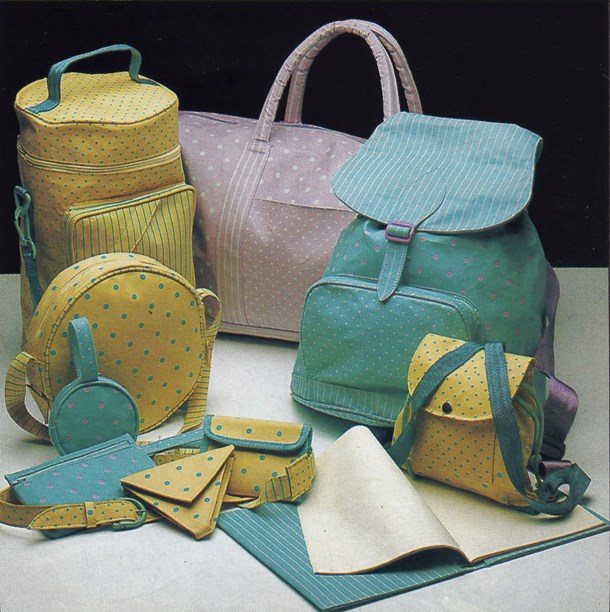
Printed canvas bags. From the Kids-stuff collection by Brigid Brock for Arpel.
Another project Brigid embarked upon was designing a sheepskin collection for an Australian company wanting to export to the United States. The garments were screen-printed by Brigid’s Christchurch printer and manufactured in Invercargill.
From promotion for USA Winter collection 1987/88 – screen-printed shearling jackets and coats and embossed and screen-printed New Zealand lambskin vests, pants and skirts. Photographed at Bondi Beach, Sydney.
In early 1987, Brigid relocated from Christchurch to Melbourne. As Marcol was still manufacturing the bulk of her range, she commuted back and forth between the two cities for the next four years.
Her 1987 collection was built around 25 garments, nine leather colours, four prints – dots, speckles, spots and geometrics – and 12 print colours. She says she never actually counted the number of different combinations within this framework but estimated it to be in the vicinity of 400.

Taupe and white screen-printed New Zealand lambskin skirt, zig-zag top and matching satchel. More magazine 1987.
Asked why she chose to focus on leather couture, she says it was probably the challenges posed by the constraints of the skins and how to make something special within those boundaries. "I like puzzles and solving problems so there was ultimately a lot of satisfaction in that. Things that are too easy tend to lose their allure for me quite quickly."
In the early 1990s, following the discovery that the director of Marcol Manufacturing had been systematically defrauding her, Brigid resigned from the company and removed all her patterns. The Marcol director was eventually found guilty of fraud and sent to prison, but Brigid says that fighting for justice for two years took its toll, leading her to change the direction of her life.
Still residing in Australia, Brigid Brock is presently involved in various property projects, but her passion is working as an art consultant, often connecting with young, upcoming artists and following their career trajectories. When time allows, she takes small groups of art collectors to New Zealand on five-day art/gallery/studio tours.
Examples of her own artistry, leather garments she designed in the 1980s and 1990s, are held in the clothing collections of the Auckland War Memorial Museum and the Museum of New Zealand Te Papa Tongarewa.
Text by Cecilie Geary. Banner image of an embossed spot English leather jacket, vest and pencil skirt with heavy elastic trim insert at hem, winter 1987.
Published May 2019.